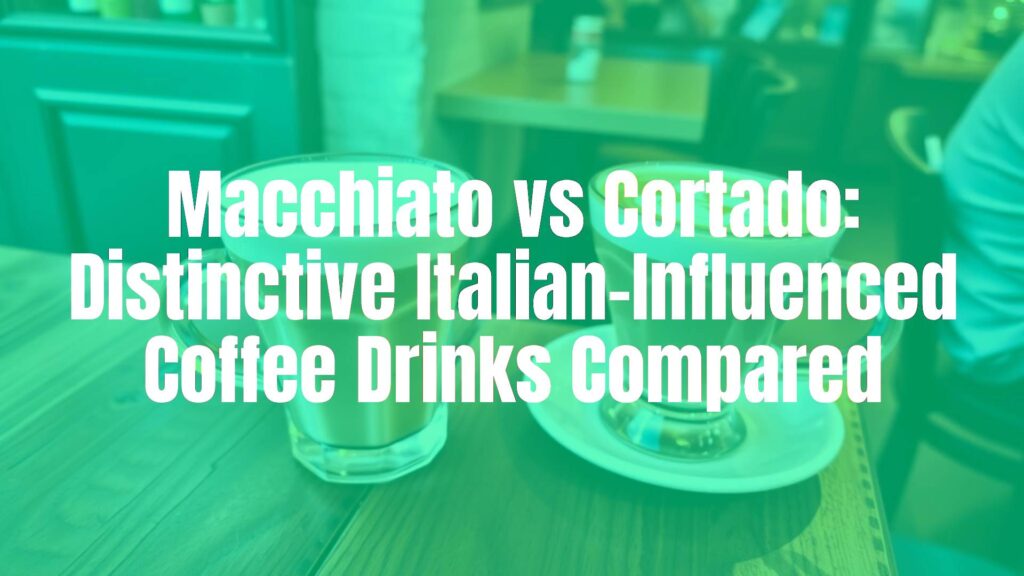Macchiato vs Cortado: A Detailed Comparison
Introduction to Two Coffee Counterparts
The macchiato and cortado are beloved espresso-based coffee drinks that blend international influences with Italian coffee culture. Both drinks balance the intensity of espresso with milk, yet subtle variations in preparation and tradition set them apart. Let’s explore what makes a macchiato and cortado unique, along with the nuances that connect and distinguish them.
Origins and Historical Background
The macchiato, which means “stained” or “spotted” in Italian, originated in Italy as a way for baristas to distinguish an espresso that had just a touch of milk added to it. The cortado has roots in Spain—its name comes from the Spanish word “cortar,” meaning “to cut,” referencing espresso “cut” with milk to moderate its intensity. Over time, each drink found global appeal and slight reinterpretations in cafes worldwide.
Key Ingredients and Proportions
Both drinks rely on espresso and milk as core ingredients, but the proportions differ significantly. A traditional macchiato consists of a shot of espresso “marked” with only a dollop of milk—sometimes foamed, sometimes just steamed—resulting in a drink that is predominantly espresso-forward. Conversely, a cortado features a near-equal ratio of espresso to steamed milk, balancing strength and creaminess more evenly.
Preparation and Serving Styles
Preparation of a macchiato is simple: a single or double espresso shot is brewed, then “stained” with a very small amount (typically a teaspoon or two) of milk. The cortado is prepared by pulling an espresso shot and adding an equal amount of steamed milk, with little to no foam, resulting in a creamier texture and larger serving size than the macchiato. The macchiato is commonly served in a demitasse (small espresso cup), while the cortado is usually offered in a small glass, often 4-5 ounces in volume.
Flavor, Texture, and Visual Differences
The macchiato has a bold, concentrated espresso flavor, as its small quantity of milk serves mostly to soften the punch of the coffee without diluting its character. Its texture remains close to that of a straight espresso, with only a hint of creaminess. The cortado, by contrast, offers a notably mellower taste—espresso’s bitterness is tempered by equal parts milk, leading to a smoother, rounder mouthfeel. Visually, a macchiato displays a distinct “spot” of milk atop dark espresso, while the cortado appears more uniformly tan due to the blended milk and coffee.
Shared Qualities and Distinguishing Features
Both drinks are espresso-based and favor minimalism, celebrating the essence of coffee without extensive sweetness or elaborate flavors. The chief distinctions are in the milk-to-espresso ratio, resulting texture, and the cultural heritage that shapes their identities. The macchiato’s sharp contrast and compact size embody Italian coffee traditions, while the cortado’s harmonious balance speaks to Spanish and Latin coffee sensibilities.
Common Misconceptions and Frequently Asked Questions
A frequent misconception is that a macchiato contains the same amount of milk as a cortado or that both are just “small lattes”; in reality, the milk content and function are markedly different. Some also associate the macchiato exclusively with the sweet, layered versions popularized by international coffee chains, which differ from the traditional Italian style discussed here. Similarly, some confuse cortado with flat white or piccolo, though the proportions and presentation are unique.
Conclusion
While both the macchiato and cortado share a foundation of espresso and milk, their distinctive preparation, taste, and cultural backgrounds offer different experiences for coffee enthusiasts. The macchiato stands out for those who want an espresso with just a hint of softness, while the cortado provides a harmonized coffee journey—perfect for anyone seeking a milder, creamy espresso drink.

